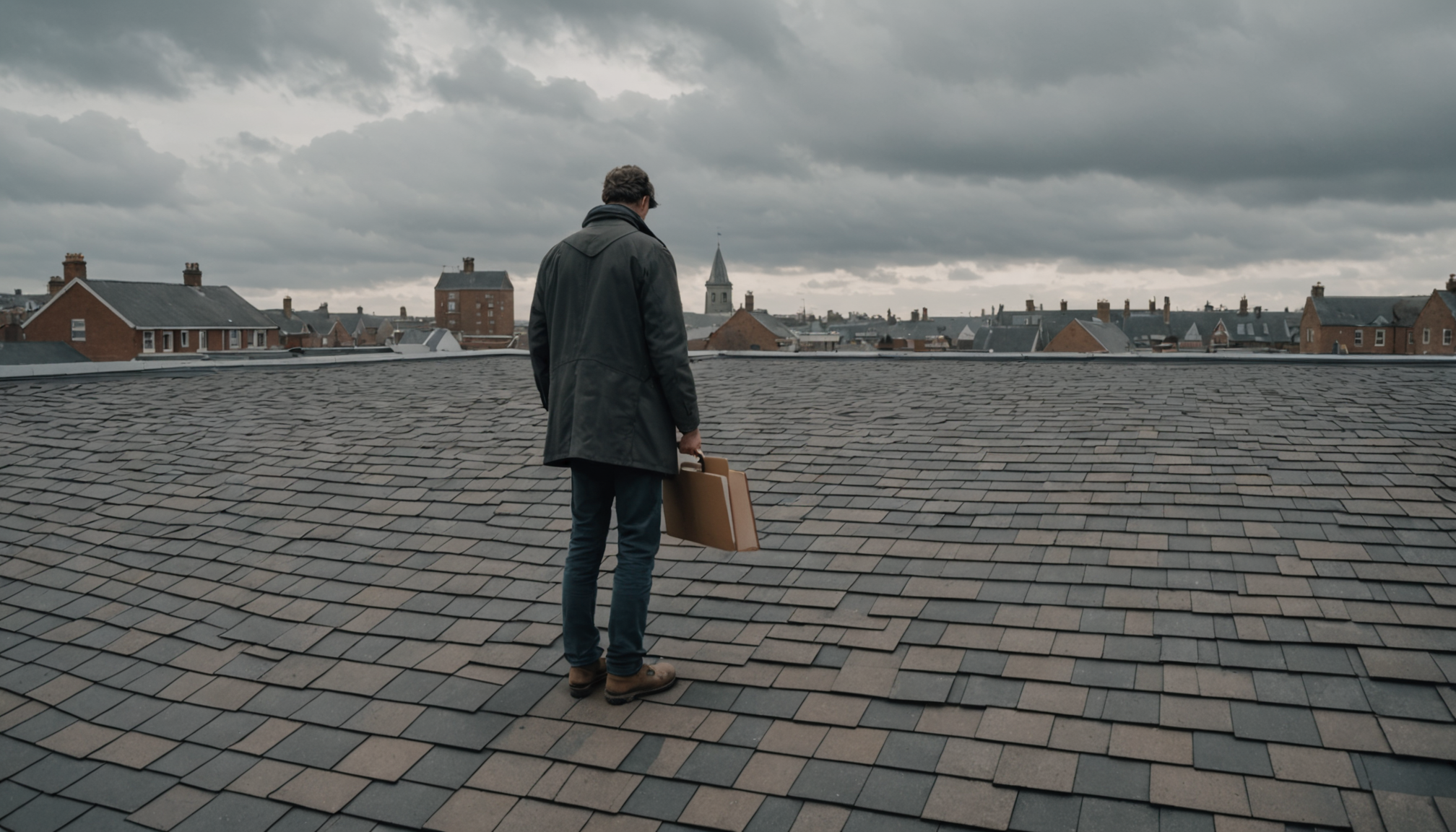Before embarking on an upgrade to your roof, it’s essential to assess the current condition of your existing structure. This preliminary evaluation helps determine the extent of repairs or replacements necessary to ensure a successful and enduring upgrade. Conducting a thorough inspection can also highlight areas that may benefit from modern improvements, such as enhanced energy savings features or improved plumbing pathways for rainwater management.
Begin by examining the exterior of your roof. Look for visible signs of wear and damage, such as missing or cracked shingles, blistering, or warping. These are indicators that tell you about the health of your roof’s surface and can give you a rough idea of the level of immediate attention required.
Next, move to the interior spaces, including the attic, to search for signs of leaks or water damage. Discoloration, mold, and damp insulation are critical signs of compromised roofing materials that could negatively impact your home’s overall efficiency and safety. If you notice any of these issues, it’s likely time for a comprehensive roof upgrade that may include updated materials and design adjustments tailored to modern standards.
Furthermore, assess the structural integrity of your roof. Check for sagging components or any areas that appear irregular. This can be a sign that the underlying structure, such as rafters and trusses, might need reinforcement or replacement. Understanding these aspects now will help to mitigate any unforeseen complications during the upgrade process and ensure that your roof’s framework supports any new modifications securely.
Roof Condition Checklist:
- Inspect for missing or damaged shingles.
- Look for signs of water damage or leaks inside the attic.
- Evaluate structural integrity for sagging or misshaped sections.
- Acknowledge energy inefficiencies that may benefit from modern materials or designs.
Finally, compare your current roofing materials and configurations with modern options to consider potential energy savings. Newer materials often come with improved insulation properties and energy efficiency ratings that could significantly reduce your energy bills over time. Consider the following comparison to better understand what might be best for your home:
| Current Material | Modern Alternative | Potential Benefits |
| Asphalt Shingles | Reflective Metal Panels | Improved energy efficiency; longer lifespan |
| Wood Shakes | Synthetic Shingles | Resistant to rot, fire, and impact |
| Basic Roll Roofing | EPDM Rubber Roofing | Enhanced waterproofing and durability |
By comprehensively assessing your current roof condition, you will be equipped with the knowledge necessary to make informed decisions when upgrading your roof, ensuring that the enhancements made are both practical and beneficial for your home’s needs and beyond. This foundational step is crucial as it sets the stage for selecting the right materials, understanding installation nuances, and considering budget requirements—all contributing to a successful roof upgrade.
selecting the right materials
When embarking on the journey to upgrade your roof, selecting the right materials is a pivotal step that significantly influences the durability, efficiency, and appearance of your home. The right choice can lead to substantial energy savings, improved aesthetic appeal, and enhanced protection against environmental factors. Here’s a strategic approach to guide you through this crucial process:
- Understand Your Needs: Begin by identifying the specific requirements for your roof. Consider the local climate, architectural style of your home, and any community regulations or guidelines. For instance, if you live in an area with heavy snowfall or strong winds, select materials known for their strength and weather resistance.
-
Research Material Options: Familiarize yourself with the different types of roofing materials available. Some popular options include:
- Asphalt Shingles: Known for their affordability and ease of installation, these are a popular choice for many homeowners. However, they have a shorter lifespan compared to other options.
- Metal Roofing: Offers durability and excellent energy savings due to its reflective properties. Metal roofs are also lightweight and fire-resistant.
- Clay and Concrete Tiles: Suitable for warmer climates, these tiles offer longevity and a distinct appearance, though they may require additional structural support due to their weight.
- Slate: Renowned for its longevity and classic appeal, slate is durable but can be costly and heavy, necessitating a robust roof structure.
- Synthetic Roofing Products: Made to mimic the look of natural materials with added benefits of lighter weight and resistance to many of the elements that can damage traditional roofing materials.
- Evaluate Energy Efficiency: With energy savings being a paramount consideration, opt for materials that enhance your home’s insulation. Products with Energy Star ratings or cool roof certifications can significantly reduce cooling costs by reflecting more sunlight and absorbing less heat.
- Consider Longevity and Maintenance: Long-term performance and maintenance are crucial when selecting roofing materials. While initial costs may be higher for materials like metal or synthetic shingles, their reduced need for maintenance and longer lifespan can offer better value over time.
- Set a Budget: Factor in not just the cost of the materials but also the associated installation expenses. Custom options or specialized products might require professional installation, impacting the overall budget. Balance between upfront costs and long-term benefits to find an affordable and effective solution.
- Seek Professional Advice: Consult with roofing professionals to gain insights based on their experience and expertise. Professionals can provide recommendations tailored to your specific conditions, helping you avoid potential pitfalls and optimize your investment.
- Evaluate Aesthetic Impact: Different materials come in various colors and finishes, which can profoundly affect the aesthetic appeal of your home. Ensure that the choice aligns with your personal taste and the exterior design of your home for a cohesive look.
With a well-rounded understanding of the available materials and a strategic approach, you’ll make informed decisions that align with your functional needs, aesthetic preferences, and financial considerations, ensuring that your roof upgrade is a valuable enhancement to your home.
understanding the installation process
The installation process is the critical phase that brings your planning and material selection to life, transforming your blueprint into a sturdy and efficient roof that can withstand the elements. Understanding each step of this process ensures not only a seamless upgrade but also maximizes the potential lifespan and effectiveness of your new roof.
Firstly, preparation is paramount to a successful installation. This preliminary stage involves clearing existing roofing materials, addressing any structural deficiencies discovered during the roof assessment, and ensuring your home is safeguarded from potential debris. Proper preparation lays a solid foundation for the new roofing materials and can prevent future complications, ultimately contributing to the enhancement of your home’s durability.
Once the old materials are removed, inspection and repairs are conducted on the underlying structure. This involves checking the wooden beams for rot, ensuring the roof deck is intact, and making necessary reinforcements. A stable base is crucial for accommodating modern roofing materials that deliver improved energy savings, allowing you to integrate advanced roofing technologies that may also improve your home’s thermal efficiency.
Next, installation of the underlayment is carried out. The underlayment acts as your roof’s second layer of defense against moisture, playing a vital role in preventing leaks. Its importance cannot be overstated, especially if you are in a region prone to heavy rainfall or snow. Modern underlayments often come equipped with advanced features like increased resistance to temperature variations, providing an enhanced barrier against weather-induced wear.
Following the underlayment, the roofing materials are installed. This step varies based on the type of material you selected, whether they’re asphalt shingles, metal sheets, or solar tiles. Each material has its specific installation technique that must be adhered to, ensuring the integrity and functionality of the roof. For instance, metal roofing might involve additional steps to secure panels properly and provide suitable spacing for thermal expansion, directly impacting your roof’s energy efficiency.
It is also during this phase that ventilation and insulation systems come into play. Adequate roofing ventilation helps regulate attic temperatures and reduce moisture buildup, which can otherwise lead to mold growth or structural damage. Effective insulation works in tandem with your roofing materials to enhance overall energy savings by reducing heating and cooling costs, promising a comfortable living environment season after season.
Once the roofing is securely in place, the installation process concludes with the finishing touches. This includes installing flashing around chimneys, plumbing vents, and skylights to prevent water infiltration, ensuring these vulnerable areas receive extra protection.
A thorough inspection by professionals generally follows the completion of the installation. This step verifies that all components are installed correctly and ensures compliance with building codes and safety standards. Professional oversight offers peace of mind, rectifying any oversights from earlier stages and affirming that your roof upgrade meets both functionality and durability standards.
By meticulously managing each segment of the installation process, you lay down the groundwork for a robust and energy-efficient roof. This thorough understanding empowers you to not only anticipate potential challenges but also make informed decisions that safeguard your investment and elevate your home’s resilience and comfort.
budgeting for your roof upgrade
When embarking on a roof upgrade, financial planning plays a crucial role in managing the project’s scope and ensuring it aligns with your budgetary capabilities. With the potential for substantial expenses, having a clear understanding of the financial landscape associated with roofing can provide peace of mind and facilitate a smoother renovation experience.
Firstly, you’ll want to get an estimate of the overall costs. Begin with a comprehensive inspection to determine the extent of repairs or new installations necessary. This will allow you to understand whether simple repairs will suffice or if a complete replacement is needed, impacting your overall expenditure. Obtaining detailed quotes from several reputable contractors can provide a comparative view of pricing, helping you make an informed decision that balances cost with quality.
Material selection is another key factor influencing your budget. As previously discussed, there is a wide array of materials available, each with its own cost implications. Asphalt shingles might be affordable upfront, but considering more durable, energy-efficient options like metal roofing could potentially lead to greater long-term savings. Additionally, modern roofing options such as solar tiles, which can harness energy and reduce utility costs, should be considered for their financial advantages beyond initial expenses.
Another important aspect that can affect budgeting is the potential need for adjustments to the roof’s structural components. If your roof requires reinforcement to support heavier materials like slate or clay, factor these additional costs into your budgeting. Remember that some regions demand certain materials or installations due to building codes or climate considerations, so be sure to account for these as you budget your supplies and labor.
Operational costs don’t end with materials and installation alone; they often extend to financing options too. Many homeowners consider mortgage refinancing or home improvement loans to help fund significant upgrades like a new roof. Exploring interest rates, loan terms, and repayment options can provide flexibility in managing large expenses over time.
Furthermore, it’s wise to leave a contingency fund within your budget. Unforeseen issues, such as discovering hidden damage or encountering delays, can arise and may require additional funds. By allocating approximately 10-15% of your budget for these unexpected conditions, you safeguard yourself against financial stress, maintaining the momentum of your project schedule.
Incorporating maintenance costs into your initial financial calculations is also beneficial. While upfront expenses are paramount, understanding the longevity and maintenance needs of your chosen materials can offer a broader perspective on affordability. Opt for options that require minimal maintenance and boast a longer lifecycle to minimize future expenses and maximize your investment.
Finally, be mindful of possible energy savings as part of the budgeting equation. Upgrading to modern materials that offer insulation benefits can significantly reduce heating and cooling costs, recouping some of the initial investment over time. By prioritizing energy-efficient materials, you not only contribute to a more sustainable home but also achieve financial benefits that complement your broader renovation budget.
By approaching your roofing upgrade with a strategic budget plan, you effectively streamline the financial aspects, allowing for adaptive decision-making and safeguarding against fiscal surprises. With adequate preparation, your investment will translate into a roof that not only enhances your home’s structural integrity but also its aesthetic and energy-efficient qualities.
maintenance tips for longevity
To ensure your new roof continues to perform effectively over the years, regular maintenance is crucial. By adopting proactive measures, you can extend the life of your roofing materials and maintain the structure’s integrity, ultimately securing your investment in the upgrade.
Begin with seasonal inspections, as they’re essential for identifying potential issues before they develop into significant problems. In the spring, inspect your roof for any damage caused by the harsh winter weather. Look for loose or missing shingles, which can be a result of heavy winds or snow buildup. Similarly, in the fall, clear away leaves and debris from gutters and downspouts to ensure proper drainage, preventing water from pooling and causing damage.
Regular cleaning is another vital component of roof maintenance. Remove any debris, such as branches or leaves, that might have accumulated on the roof. This not only helps prevent mold growth and rot but also deters pests from nesting. Use a roof-friendly cleaner tailored for your specific material to remove algae or moss, particularly on shaded surfaces.
Roofing issues often start small but can quickly escalate if unnoticed or ignored. Therefore, address minor repairs promptly to prevent them from becoming costly fixes. Replace damaged shingles, secure loose flashing, and reseal joints and seams to maintain the roof’s water-resistant barrier. Enlist professional help when needed to ensure repairs are handled correctly and safely.
Check the attic’s interior regularly for signs of moisture, such as water stains, mold, or musty odors. These can indicate leaks or ventilation issues that could compromise the roofing structure. Adequate ventilation plays a crucial role in the overall energy efficiency and health of your roof. It reduces moisture buildup, which can lead to rot and mold, and helps maintain a comfortable indoor temperature by regulating airflow.
Consider scheduling periodic professional inspections to complement your maintenance regimen. Experts can identify small or hidden issues that may escape untrained eyes and provide insights into the condition of your roofing system. They can assess materials for age-related wear and ensure that plumbing vents and flashing remain secure, offering recommendations to sustain your roof’s longevity effectively.
Ultimately, a modern roof that incorporates advanced materials and reflects comprehensive maintenance practices can yield significant energy savings, enhancing your home’s efficiency. By investing time in regular upkeep, you preserve the functional and aesthetic benefits of your roof upgrade, ensuring your home remains protected and retains its value.
In conclusion, upgrading your roof is a rewarding endeavor that combines improved durability, energy savings, and aesthetic appeal, all of which enhance your home’s value and comfort. From assessing the current condition and choosing the right materials to understanding the installation process, a thoughtful approach ensures your investment retains its worth. Commitment to regular maintenance further extends the longevity and efficiency of your roofing system, allowing you to enjoy the benefits for years to come.


